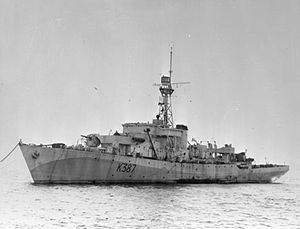HMS Berkeley Castle (K387)
 Berkeley Castle on the River Clyde, December 1943
| |
| History | |
|---|---|
| Name | HMS Berkeley Castle |
| Namesake | Berkeley Castle |
| Builder | Barclay, Curle & Co. Ltd |
| Laid down | 23 March 1943 |
| Launched | 19 August 1943 |
| Commissioned | 18 November 1943 |
| Identification | Pennant number: K387 |
| Fate | Scrapped 29 February 1956 |
| General characteristics | |
| Class and type | Template:Sclass2- |
HMS Berkeley Castle was a Castle-class corvette of the United Kingdom's Royal Navy. She was named after Berkeley Castle in Gloucestershire.
Design
The Castle-class corvettes were an improved and enlarged derivative of the earlier Flower-class corvettes, which was intended to be built by shipyards that could not build the larger and more capable frigates. The greater length of the Castles gave made them better seaboats than the Flowers, which were not originally designed for ocean escort work. Large numbers (96 in total) were ordered in late 1942 and early 1943 from shipyards in the United Kingdom and Canada, but Allied successes in the Battle of the Atlantic meant that the requirement for escorts was reduced, and many ships (including all the Canadian ones) were cancelled.[1][2]
The Castles were 252 feet 0 inches (76.81 m) long overall, 234 feet 0 inches (71.32 m) at the waterline and 225 feet 0 inches (68.58 m) between perpendiculars. Beam was 36 feet 6 inches (11.13 m) and draught was 13 feet 5 inches (4.09 m) aft at full load.[3] Displacement was about 1,060 long tons (1,080 t) standard and 1,590–1,630 long tons (1,620–1,660 t) full load.[4] Two Admiralty Three-drum water tube boilers fed steam to a Vertical Triple Expansion Engine rated at 2,750 indicated horsepower (2,050 kW) which drove a single propeller shaft. This gave a speed of 16.5 knots (19.0 mph; 30.6 km/h).[4] 480 tons of oil were carried, giving a range of 6,200 nautical miles (7,100 mi; 11,500 km) at 15 knots (17 mph; 28 km/h).[5]
The ships had a main gun armament of a single QF 4-inch Mk XIX dual-purpose gun, backed up by two twin and two single Oerlikon 20 mm cannon.[5] Anti-submarine armament consisted of a single triple-barrelled Squid anti-submarine mortar with 81 charges backed up by two depth charge throwers and a single depth charge rail, with 15 depth charges carried. Type 272 or Type 277 surface search radar was fitted, as was high-frequency direction finding (HF/DF) gear. The ships' sonar outfit was Type 145 and Type 147B.[6]
Service
Berkley Castle was one of five Castle-class corvettes ordered on 2 February 1943. She was laid down at the Barclay Curle shipyard in Glasgow on 23 April 1943, launched on 19 August and commissioned on 18 November 1943.[7] She served as a convoy escort until the end of the Second World War. She was the first ship in the Indian Ocean war theatre to discover the Second World War had ended in Europe. Telegraphist Kenneth Bromwich received the message whilst stationed off the coast of Ceylon.[citation needed]
She was then placed in reserve at Harwich. She suffered serious damage when she capsized in dock at Sheerness during severe flooding in February 1953 but was refloated and repaired. She was in reserve at Sheerness until 1956. She arrived at Thos W Ward Grays in Essex on 29 February 1956 for scrapping.
References
- ^ Friedman 2008, p. 156
- ^ Brown 2012, p. 136
- ^ Friedman 2008, p. 324
- ^ a b Gardiner & Chesneau 1980, p. 63
- ^ a b Elliott 1977, p. 205
- ^ Brown 2007, pp. 126–127
- ^ Friedman 2008, p. 344
Publications
- Brown, David K. (2007). Atlantic Escorts: Ships, Weapons & Tactics in World War II. Barnsley, UK: Seaforth Publishing. ISBN 978-1-84415-702-0.
{{cite book}}: Invalid|ref=harv(help) - Brown, David K. (2012). Nelson to Vanguard: Warship Design and Development 1923–1945. Barnsley, UK: Seaforth Publishing. ISBN 978-1-84832-149-6.
{{cite book}}: Invalid|ref=harv(help). - Colledge, J. J.; Warlow, Ben (2006) [1969]. Ships of the Royal Navy: The Complete Record of all Fighting Ships of the Royal Navy (Rev. ed.). London: Chatham Publishing. ISBN 978-1-86176-281-8.
{{cite book}}: Invalid|ref=harv(help) - Critchley, Mike (1992). British Warships Since 1945: Part 5: Frigates. Liskeard, UK: Maritime Press. ISBN 0-907771-13-0.
{{cite book}}: Invalid|ref=harv(help) - Elliott, Peter (1977). Allied Escort Ships of World War II: A Complete Survey. London: Macdonald and Jane's. ISBN 0-356-08401-9.
{{cite book}}: Invalid|ref=harv(help) - Friedman, Norman (2008). British Destroyers & Frigates: The Second World War and After. Barnsley, UK: Seaforth Publishing. ISBN 978-1-84832-015-4.
{{cite book}}: Invalid|ref=harv(help) - Gardiner, Robert; Chesneau, Roger, eds. (1980). Conway's All The World's Fighting Ships 1922–1946. London: Conway Maritime Press. ISBN 0-85177-146-7.
{{cite book}}: Invalid|ref=harv(help)
